(391-2410) Update of OnStar system
Symptom: The OnStar system cannot be activated.
|
MODIFICATION INSTRUCTION
|
|
Bulletin Nbr:
|
391-2410
|
|
Date:
...........
|
May 2003
|
|
Market:
|
CA
|
|
Customer Satisfaction Campaign 154 21
|
Cars in stock must be rectified before delivery.
A personal communication must be sent to the owners of cars already
delivered requesting them to get in touch with the nearest Saab garage as
soon as possible to have the fault rectified.
Saab 9-3 (9440) M03 with VIN within the interval 31000012-31026045
All cars are not affected, see separate information.
The car must be updated so that the OnStar system can be activated.
The software in ICM and ACC must also be updated to improve background lighting.
Symptom description
The OnStar system cannot be activated.
12 789 494 OnStar Keypad
12 802 004 Cupholder
12 802 264 Spacer
12 803 274 Telematic Unit (CU), English version
12 801 949 Telematic Unit (CU), French version
|
Note
|
|
In order to perform this work the following special tools are required:
|
|
-
|
PC with installed TIS 2000
|
|
-
|
Hardware lock with adapter
|
|
-
|
PC cable with RS232 adapter
|
|
-
|
Tech2 with 32 Mb card
|
|
-
|
CANdi box
|
Brief instructions
It is important that all measures are performed in the prescribed order.
ICM must be updated first because new software in ICM is required to make
it possible to carry out certain subsequent measures.
The procedure to be completed is structured according to the following
stages:
|
A.
|
Update of TIS 2000 with CD TIS 2000 2003-1 or later.
|
|
B.
|
Update of Tech2 software to version 105.500 or later.
|
|
C.
|
Preparing the car for software update.
|
Note
|
|
In order to save time, Tech2 should be connected to both the car and
the PC during the entire update procedure.
|
|
Important
|
|
No PC in proximity to the car:
If Tech2 disconnects
from the car, the CANdi box should be disconnected from Tech2. The CANdi box
may remain connected to the car's data link connector.
|
|
|
|
|
D.
|
Update of car software and hardware replacement according to the
accompanying checklist (supplement D1).
|
|
A. Update of TIS 2000 with CD TIS 2000 2003-1 (or later).
|
|
Note
|
|
If the computer on which TIS 2000 is installed has already been updated
to TIS 2000 2003-1 (or later), there is no need to update the computer again.
|
|
1.
|
Insert CD TIS 2000 2003-1 (or later) into the computer.
|
|
3.
|
Follow the instructions in TIS 2000.
|
|
B. Update of Tech2 software
|
Tech2 with new 105.500 (or later) software is required for SPS programming
and to “Add” control modules.
It is very important that Tech2 is updated to version 105.500 (or later)
before the following procedures are completed.
Follow the instructions in TIS 2000 and Tech2 in order to update the
software in Tech2.
|
C. Preparing the car for software update
|
The entire procedure is indicated on the checklist (Supplement D1),
which can be used as a guide during the entire process. One copy of the checklist
should be printed out for each car receiving an update.
|
Important
|
|
SPS programming must not be interrupted due to a loosened diagnostics
cable or insufficient battery voltage, for example.
|
|
The car's power consumption is high during control module programming.
Always connect a battery charger during SPS programming.
|
|
Do not activate any switches in the car e.g. opening/closing doors or
windows, etc. Programming could be interrupted and the control module could
be damaged to such an extent that it is no longer functional.
|
|
The engine control module ECM (petrol) can become unusable if programming
is interrupted; for example, if the diagnostics cable comes loose or the battery
voltage is too low. There is a risk that the other control modules may become
damaged and unusable.
|
|
During SPS programming, all normal bus communication is stopped. As
a result, the main fuse boxes assume Limp Home mode and switch on the dipped
beams and rear lighting.
|
|
|
|
D. Update of car software and hardware replacement
|
|
Important
|
|
It is extremely important that the measures are carried out in the prescribed
order.
|
|
|
|
Note
|
|
Enter the car's VIN and equipment level in the table header of the checklist
(supplement D1) before proceeding. This facilitates work and saves time. So
that the correct alternative can be chosen when “Add” is executed,
check in SID whether there are menu options for parking and engine block heaters.
|
Replacing the cupholder
|
1.
|
Remove the centre panel vent by carefully bending in the upper
hooks (A and B) on the upper section accessible through the grille. At the
same time draw the left-hand locating pin directly outwards at the same time
as the lower hook (D) is undone. Draw in the right-hand locating pin and undo
the upper hook (C). Remove the panel vent.
|
Note
|
|
To avoid the air vent falling apart it is important to bend the correct
hooks. The hooks holding the air vent together are also visible through the
grille.
|

|
|
2.
|
Remove the control panel of the infotainment system (ICM unit).
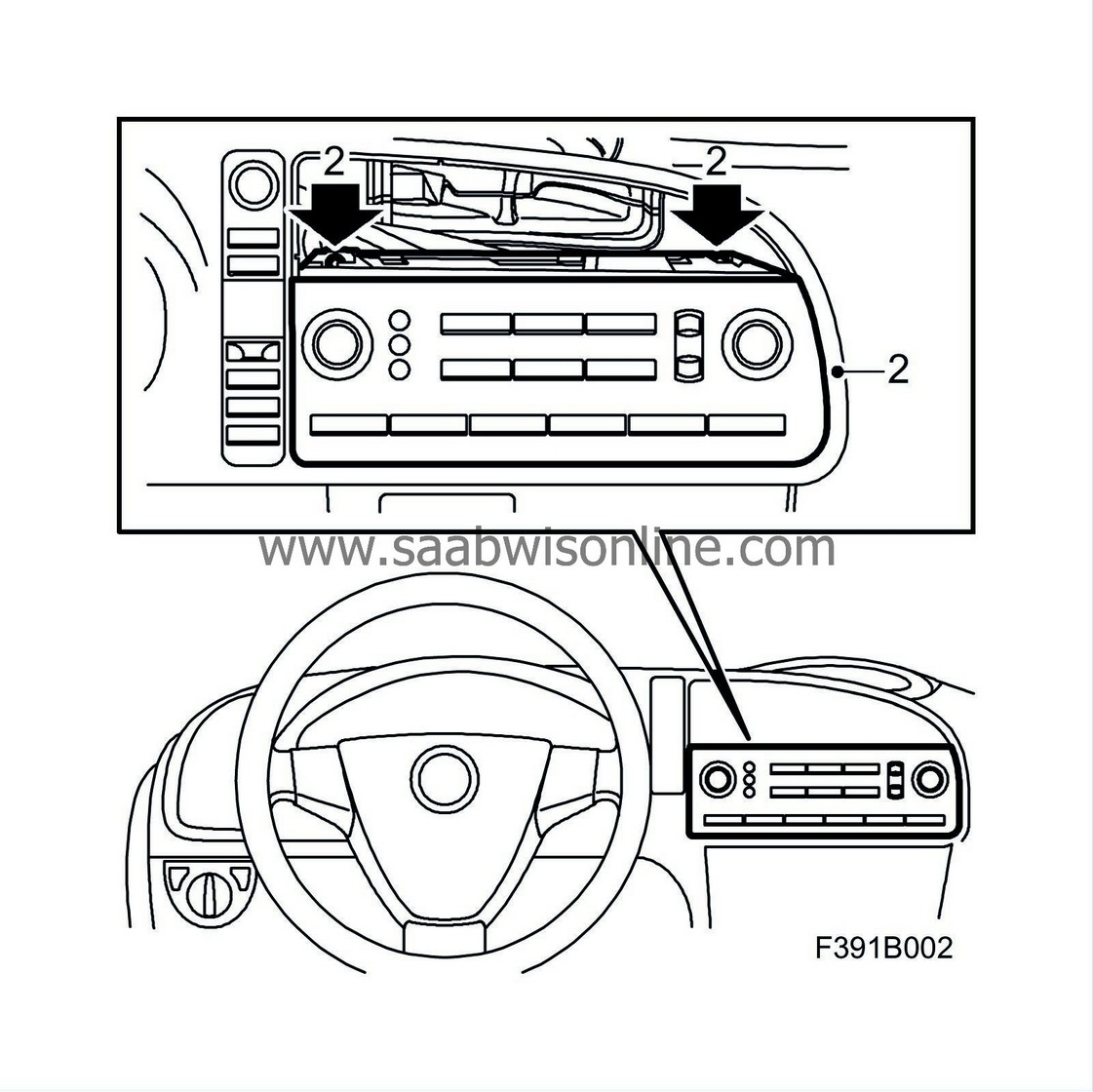
|
|
3.
|
Remove the SID unit control panel (SIDC) from the rear by pressing
the two tabs together and then pressing the SIDC forward. Start with the top
edge.
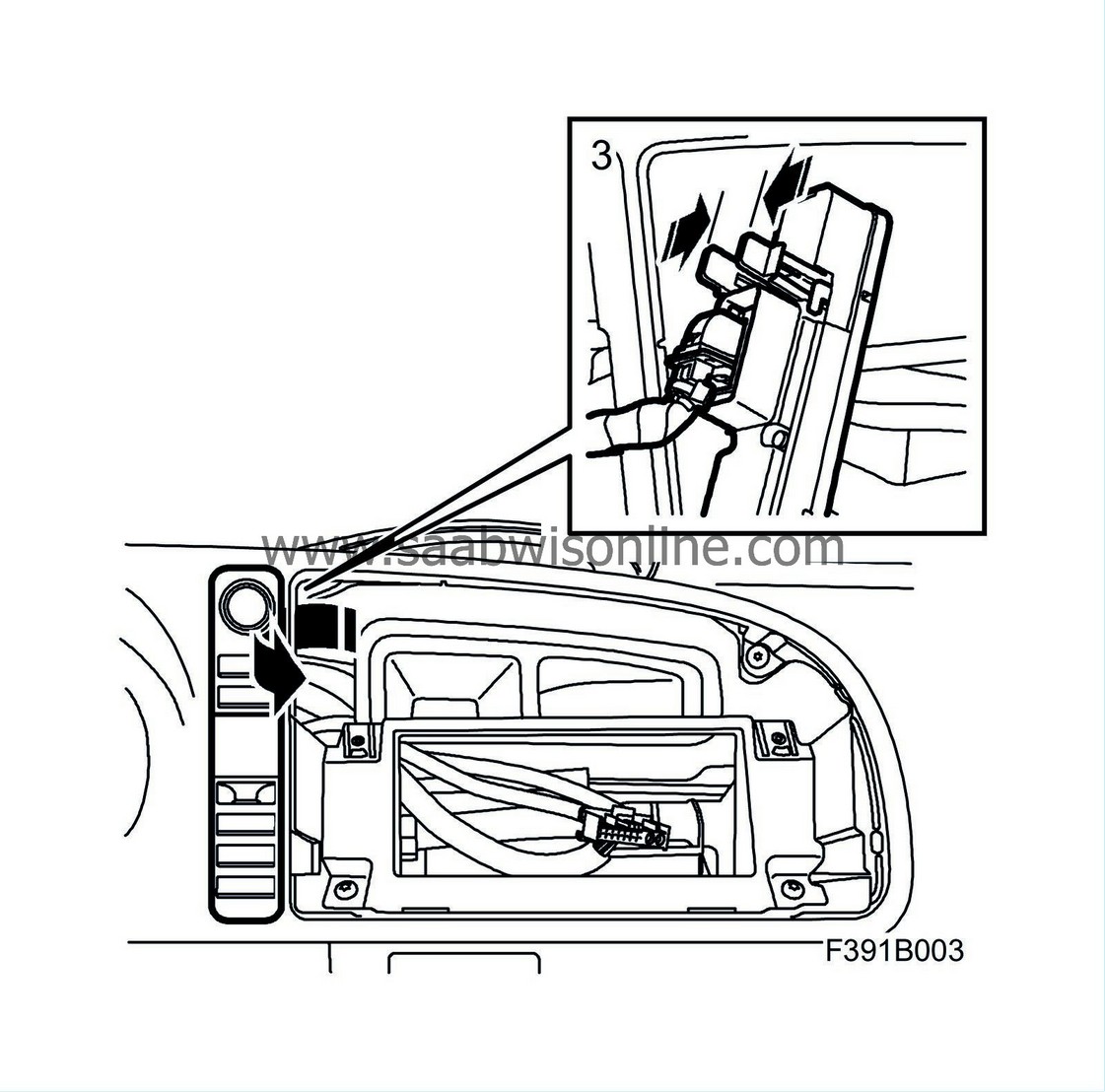
|
|
4.
|
Remove the screws from the instrument plate.

|
|
5.
|
Depress the catches on the top of the cup holder and withdraw
the holder.
|
Note
|
|
Lift the frame of the main instrument unit up and out slightly to make
it easier to remove the cupholder.
|
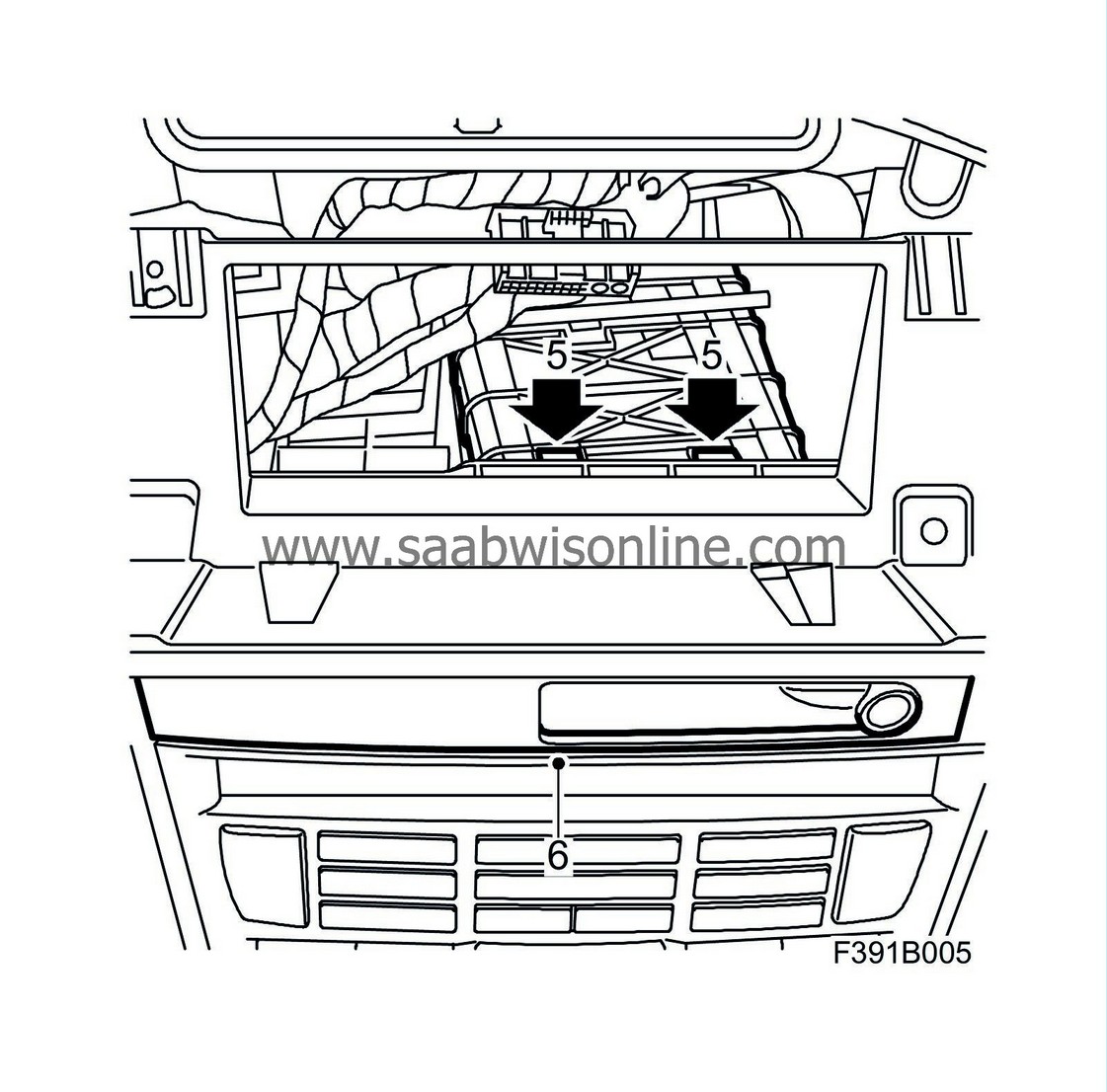
|
|
6.
|
Lift out the cupholder.
|
|
7.
|
Remove the ACC/MCC unit by carefully pulling it out. Use the removal
tool, part no. 82 93 474.
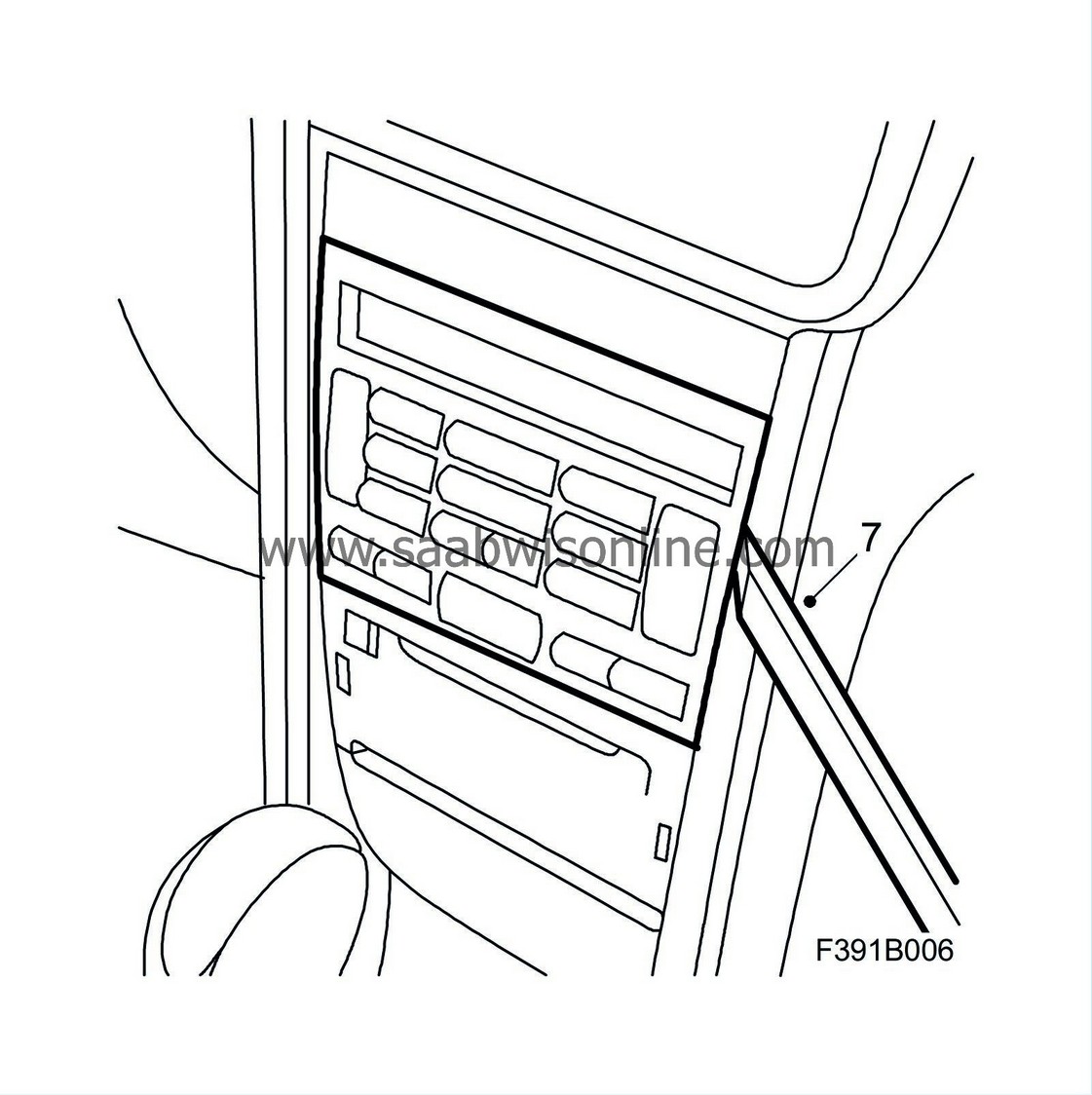
|
|
8.
|
Remove the tape from the wiring harness of the OnStar buttons.
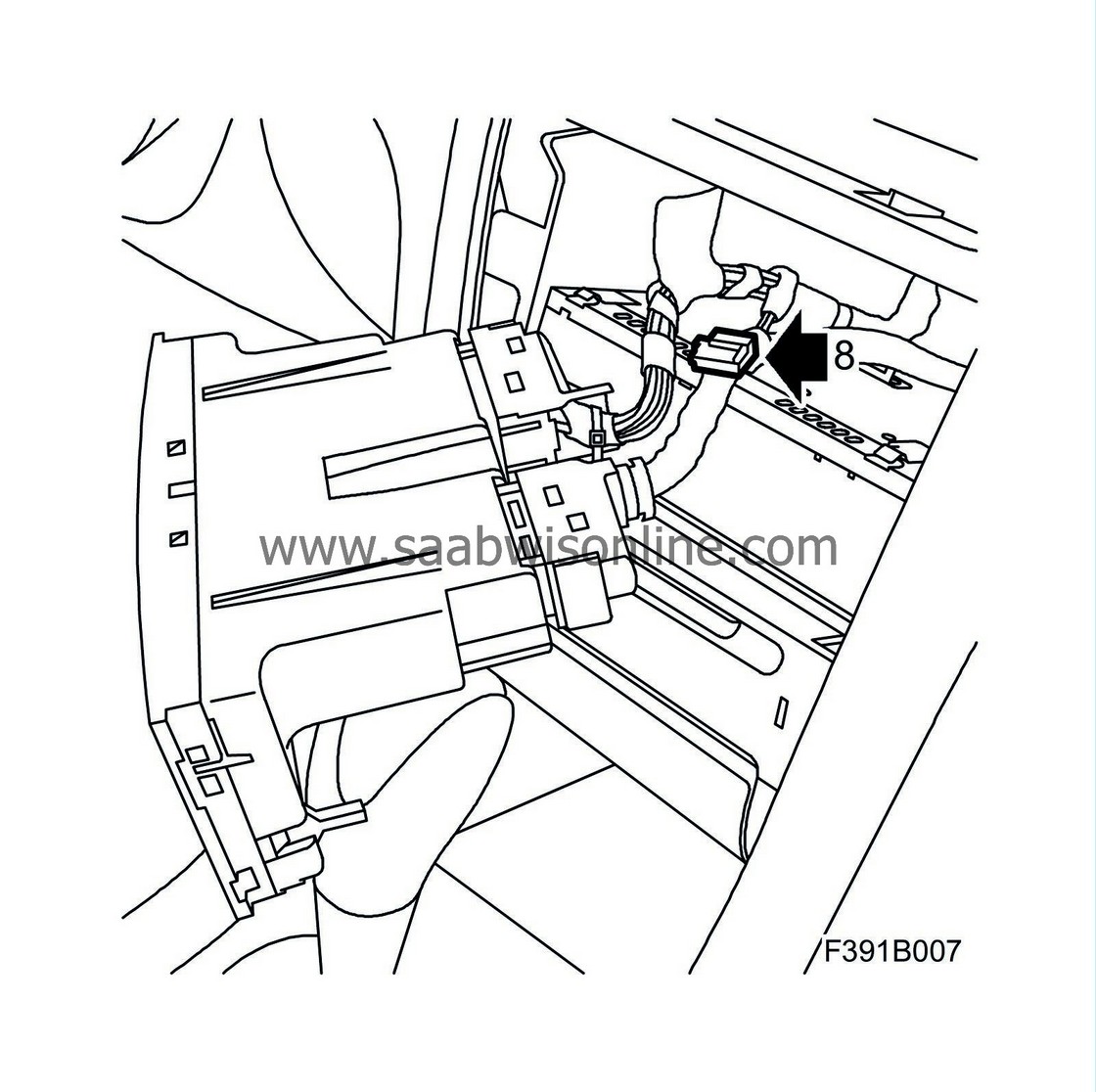
|
|
9.
|
Cut 5 mm off the right-hand support of the cupholder. Measure
precisely.
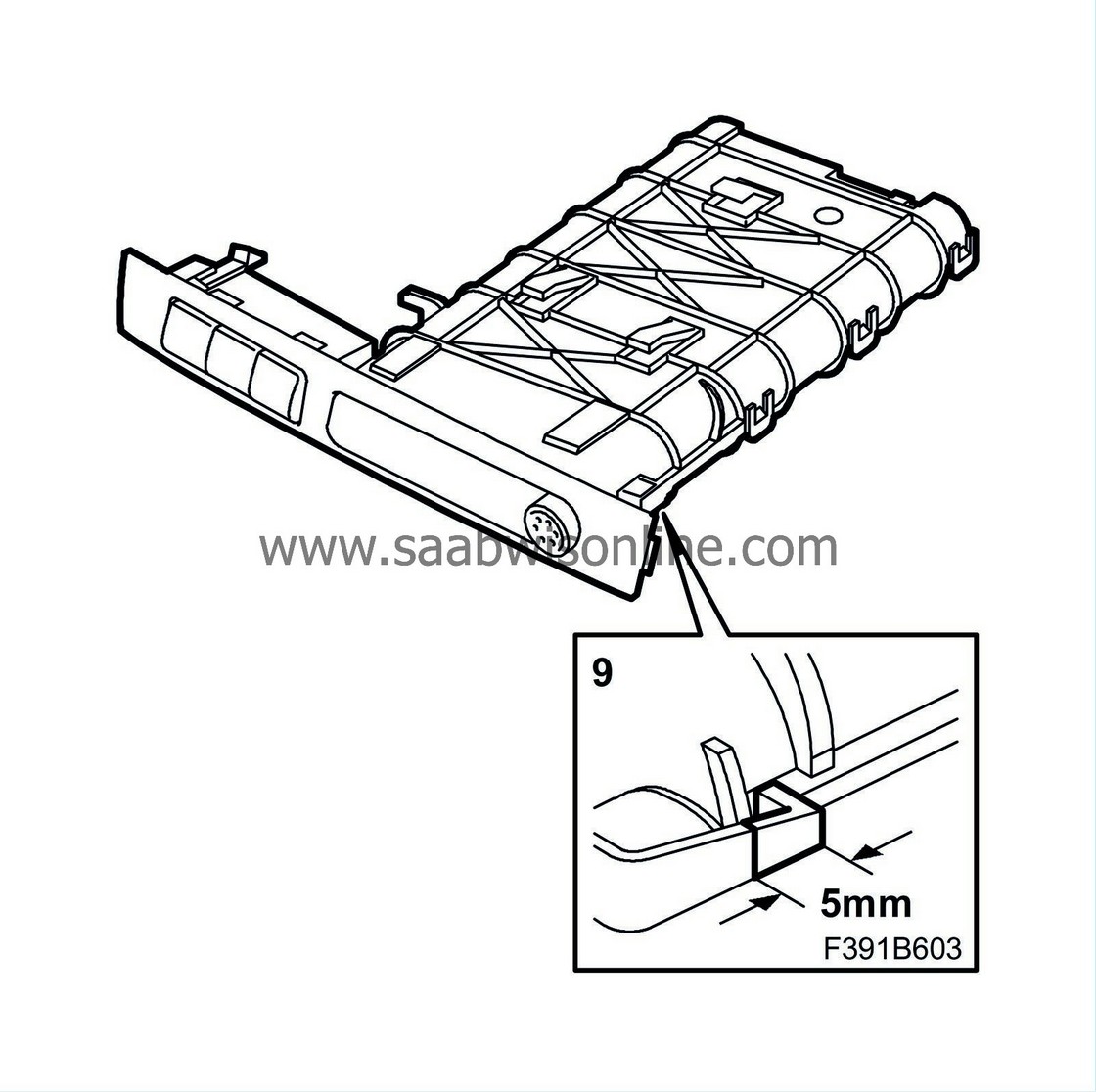
|
|
10.
|
Cut off 1 mm from the 3 clefts holding the cupholder. Measure
precisely.

|
|
11.
|
Fit the thin spacer at the top of the inside of the right-hand
cleft.
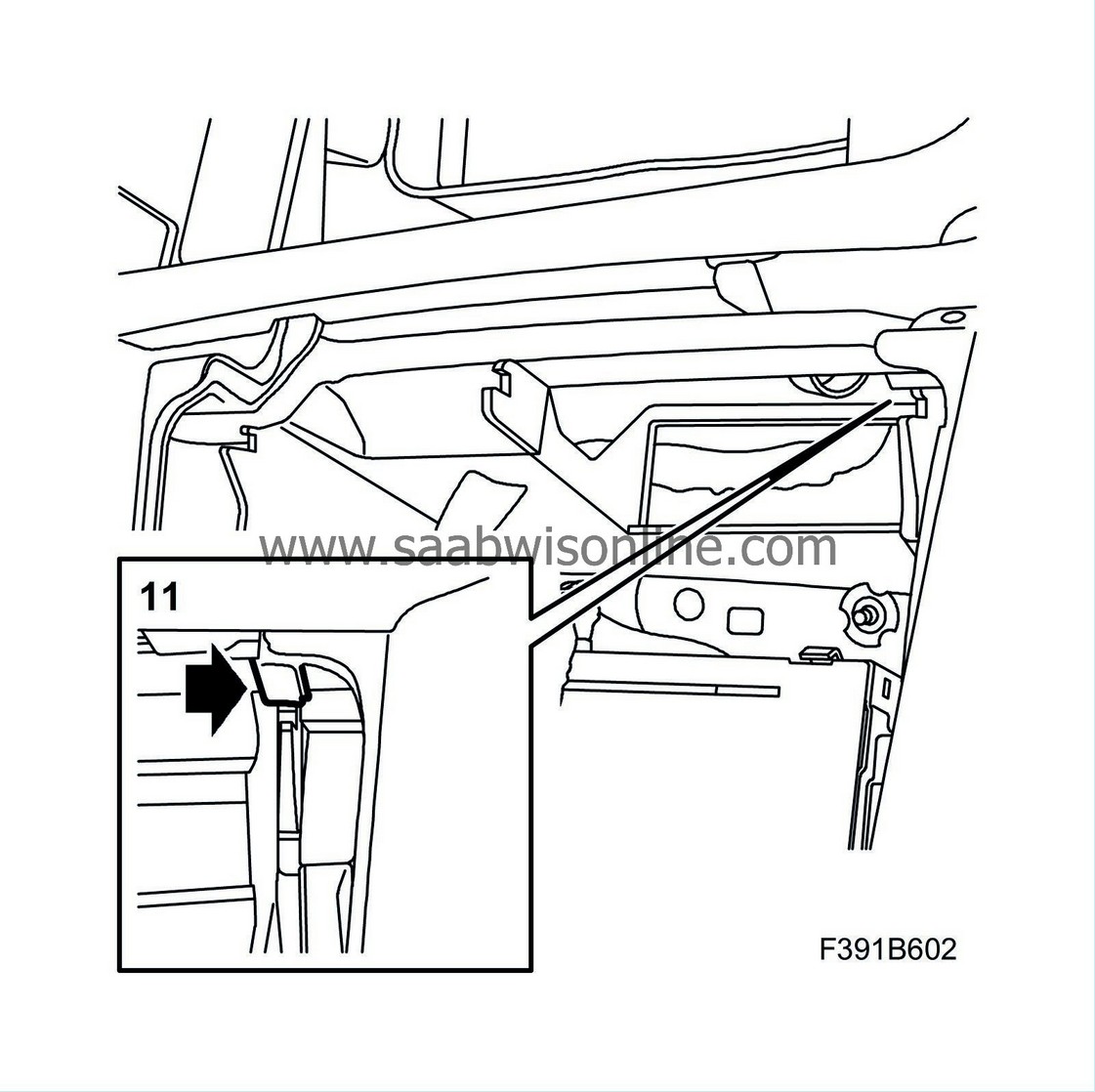
|
|
12.
|
Remove the protective paper and fit the thicker spacers on the
left-hand clip and the rear of the right-hand front.
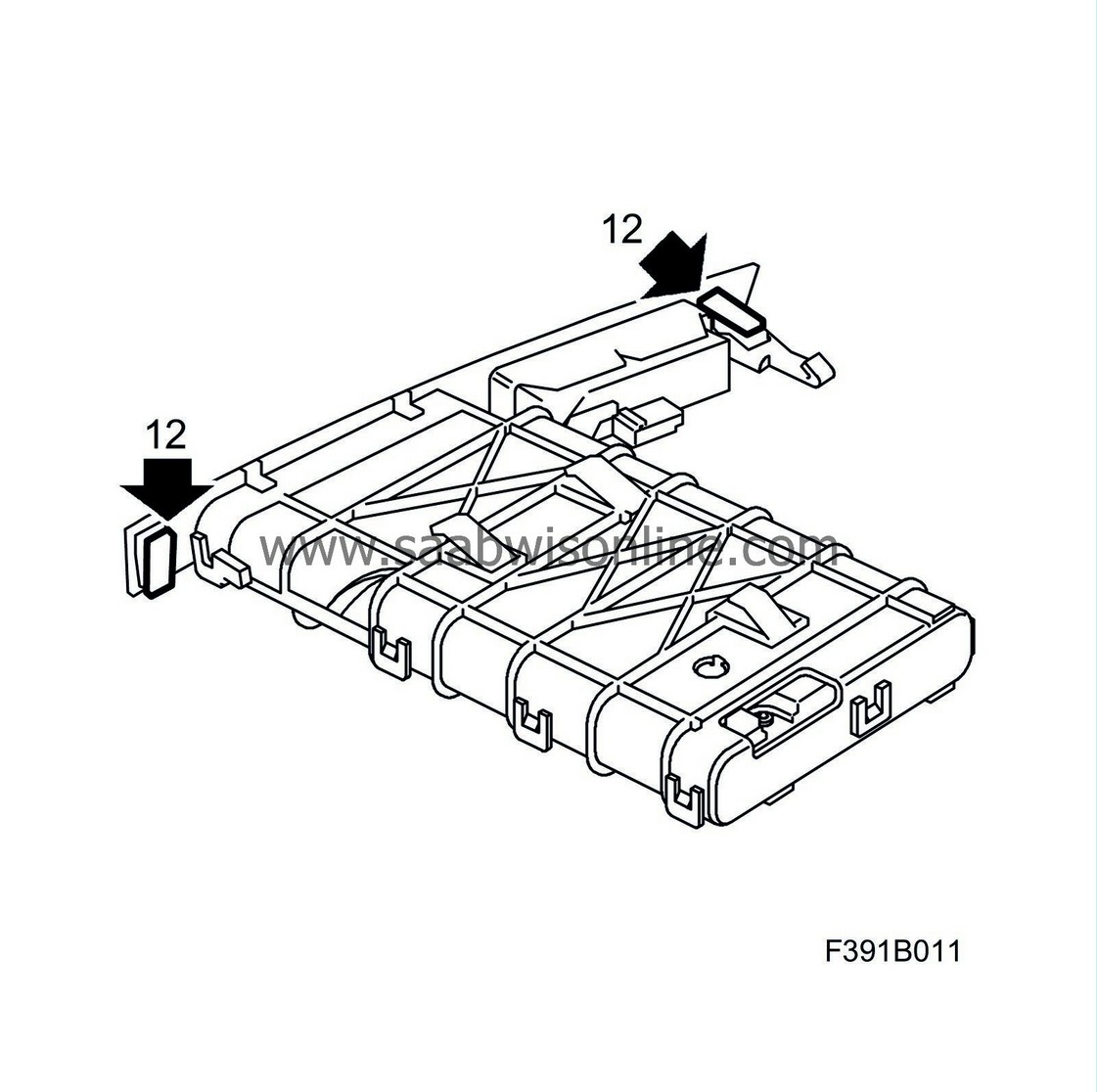
|
|
13.
|
Plug in the connector for the OnStar buttons.
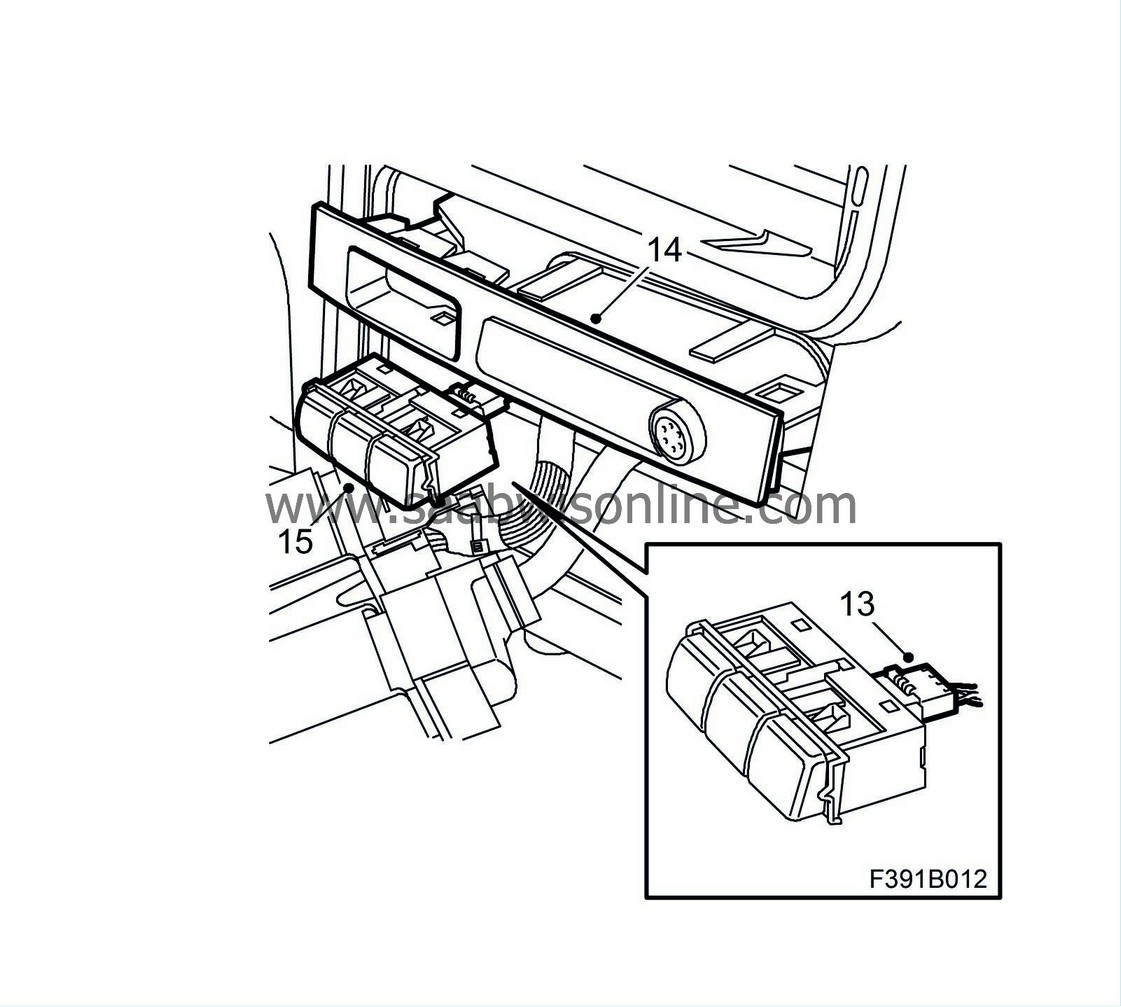
|
|
14.
|
Fit the new cupholder in the panel, pressing it in so that it
snaps in place.
|
|
15.
|
Press in the OnStar keypad from the back so that it snaps in place.
|
|
16.
|
Fit the ACC/MCC unit.
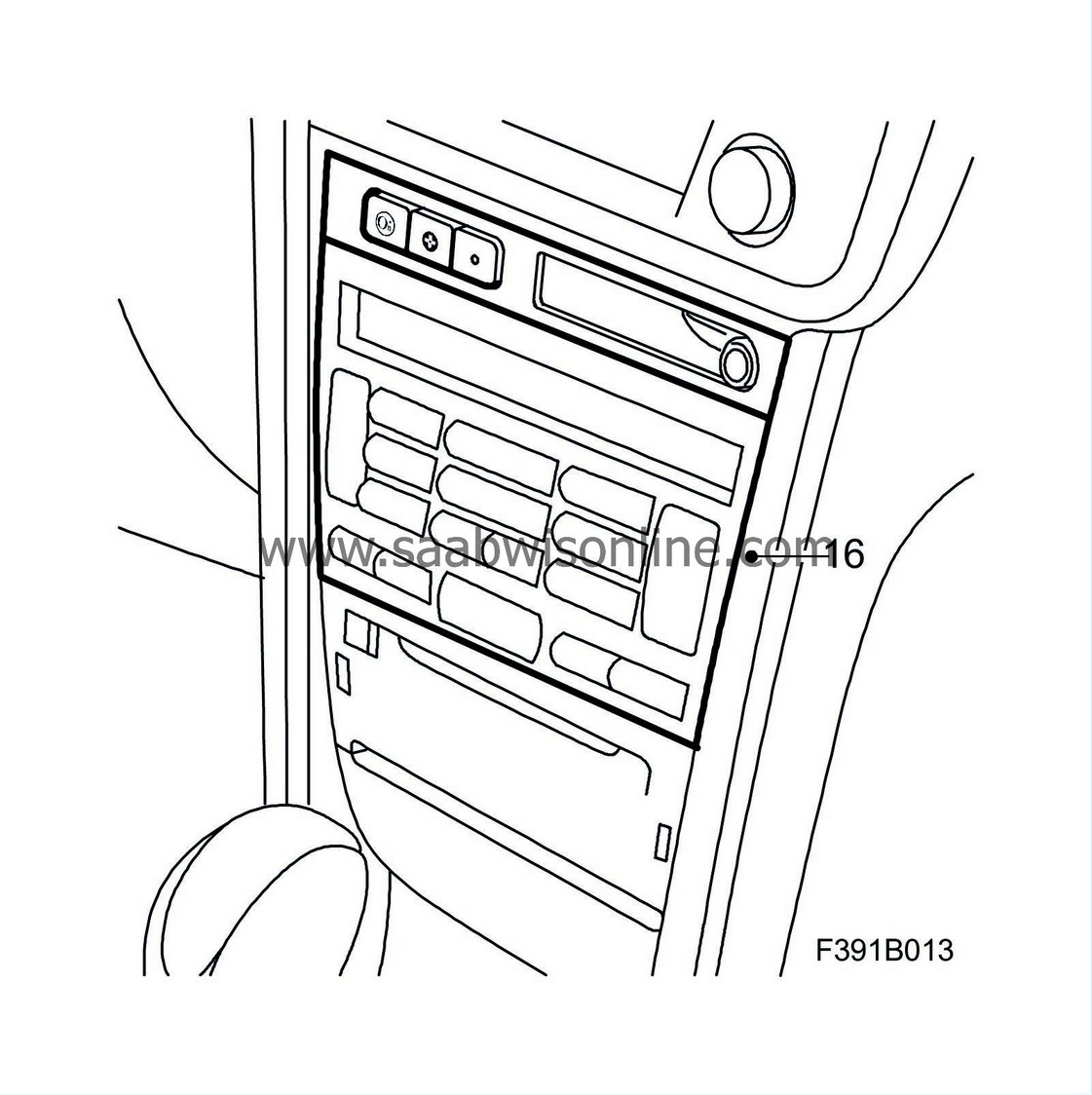
|
|
17.
|
Check the functionality of the cupholder.
|
|
18.
|
Fit the instrument plate screws.
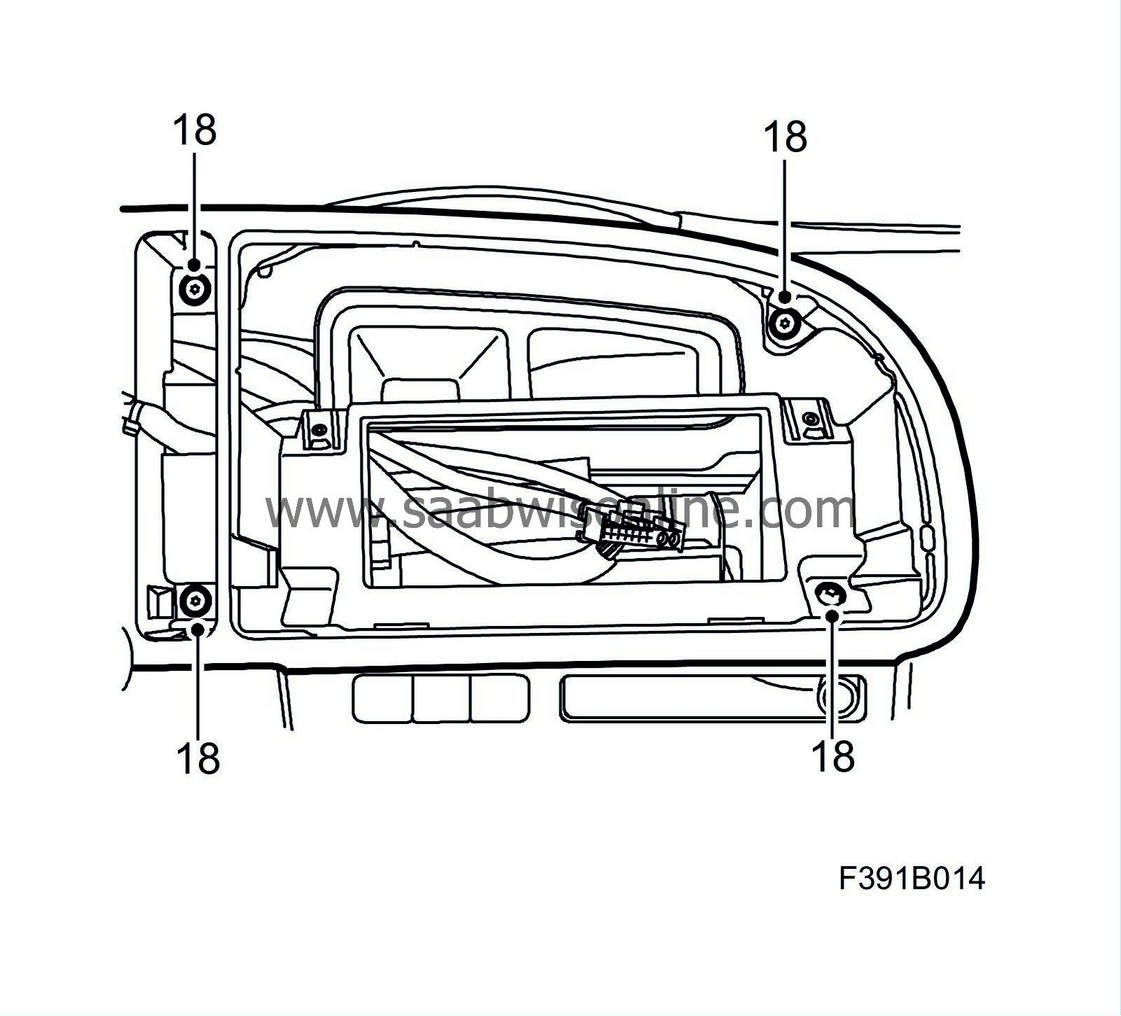
|
|
19.
|
Fit SIDC by fitting the catch in the lower edge and then pressing
the upper edge into place.
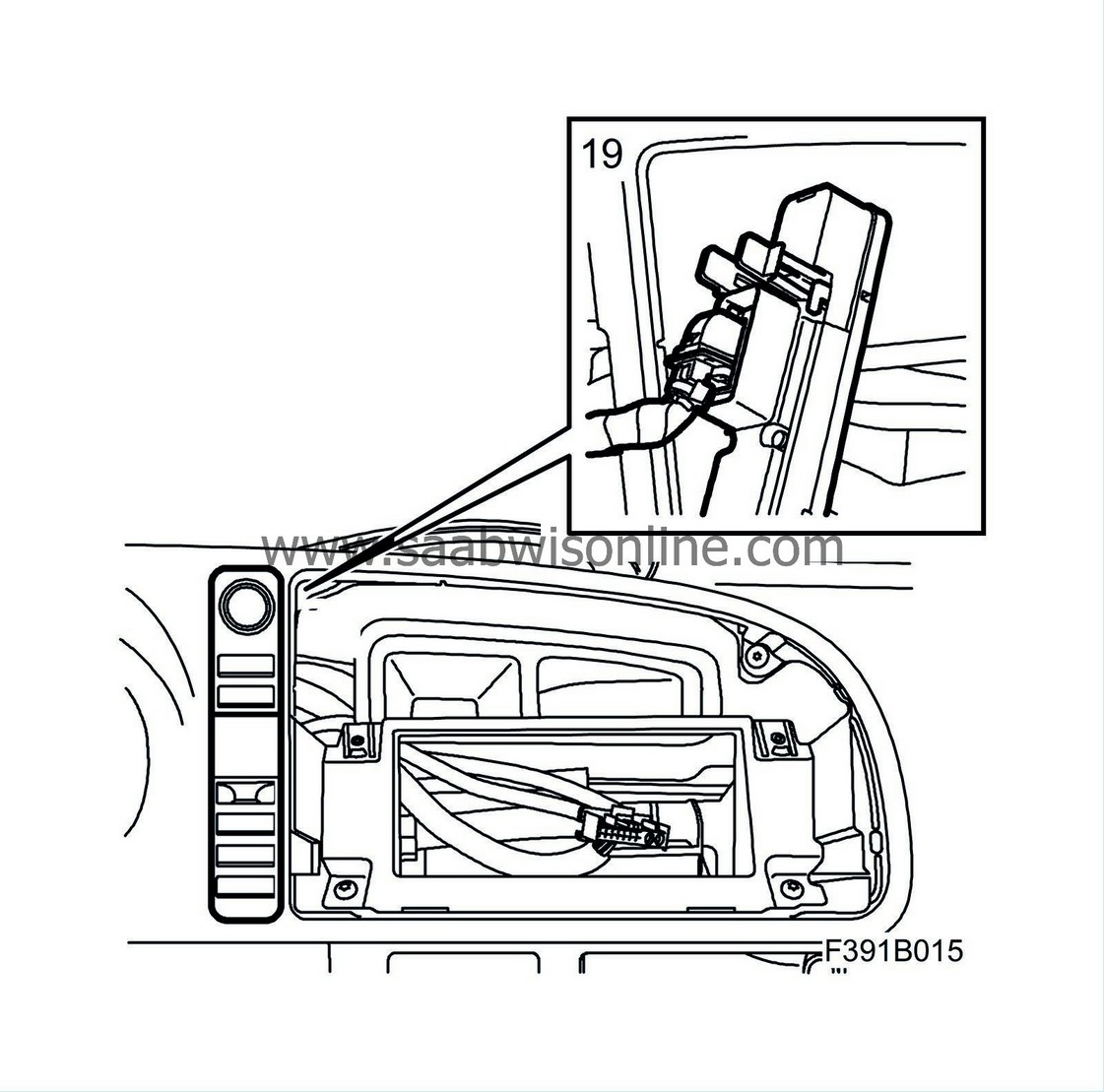
|
|
20.
|
Fit the ICM unit.
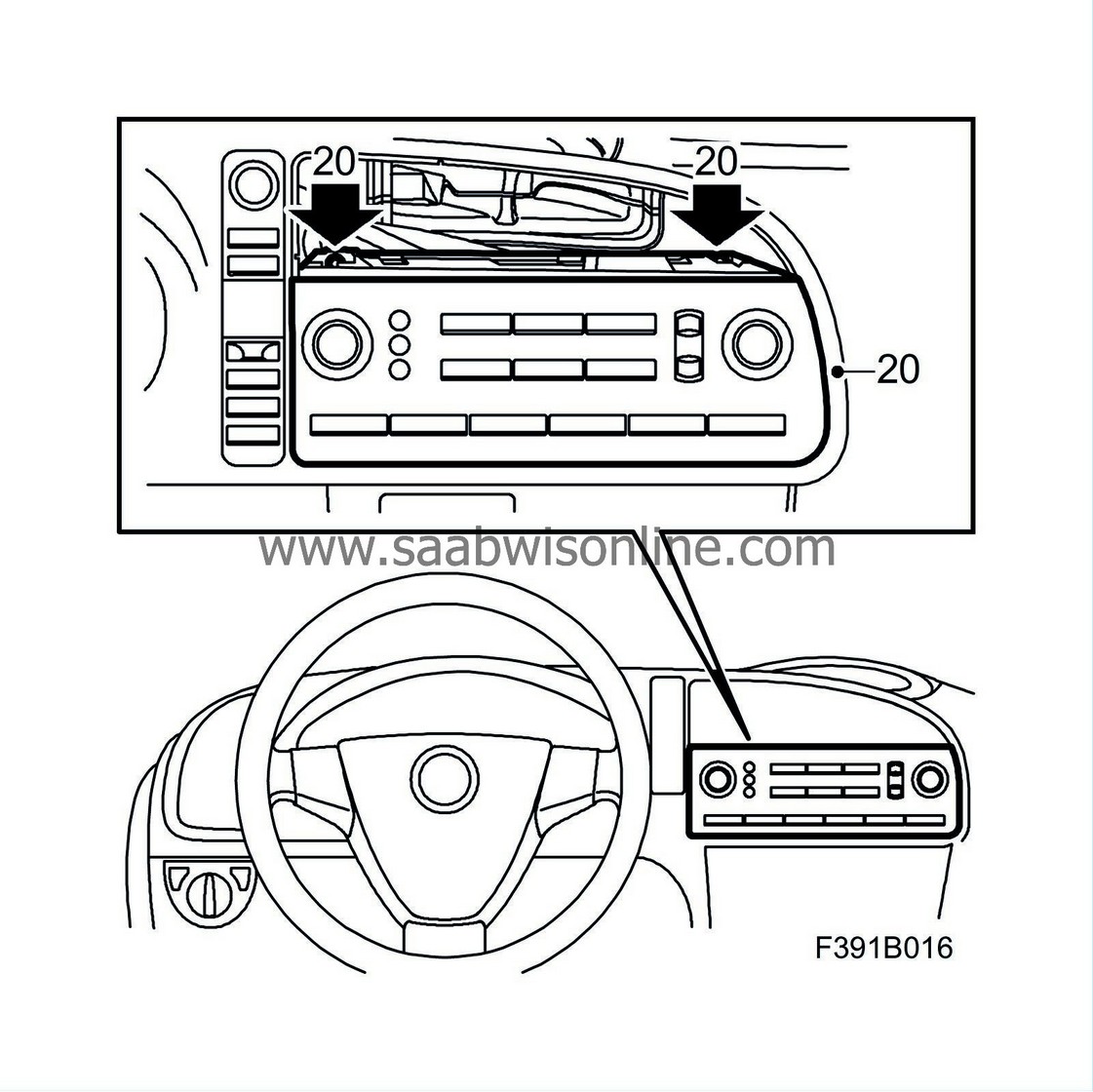
|
|
21.
|
Position and fit the centre panel vent. Make sure that the catches
fasten securely.
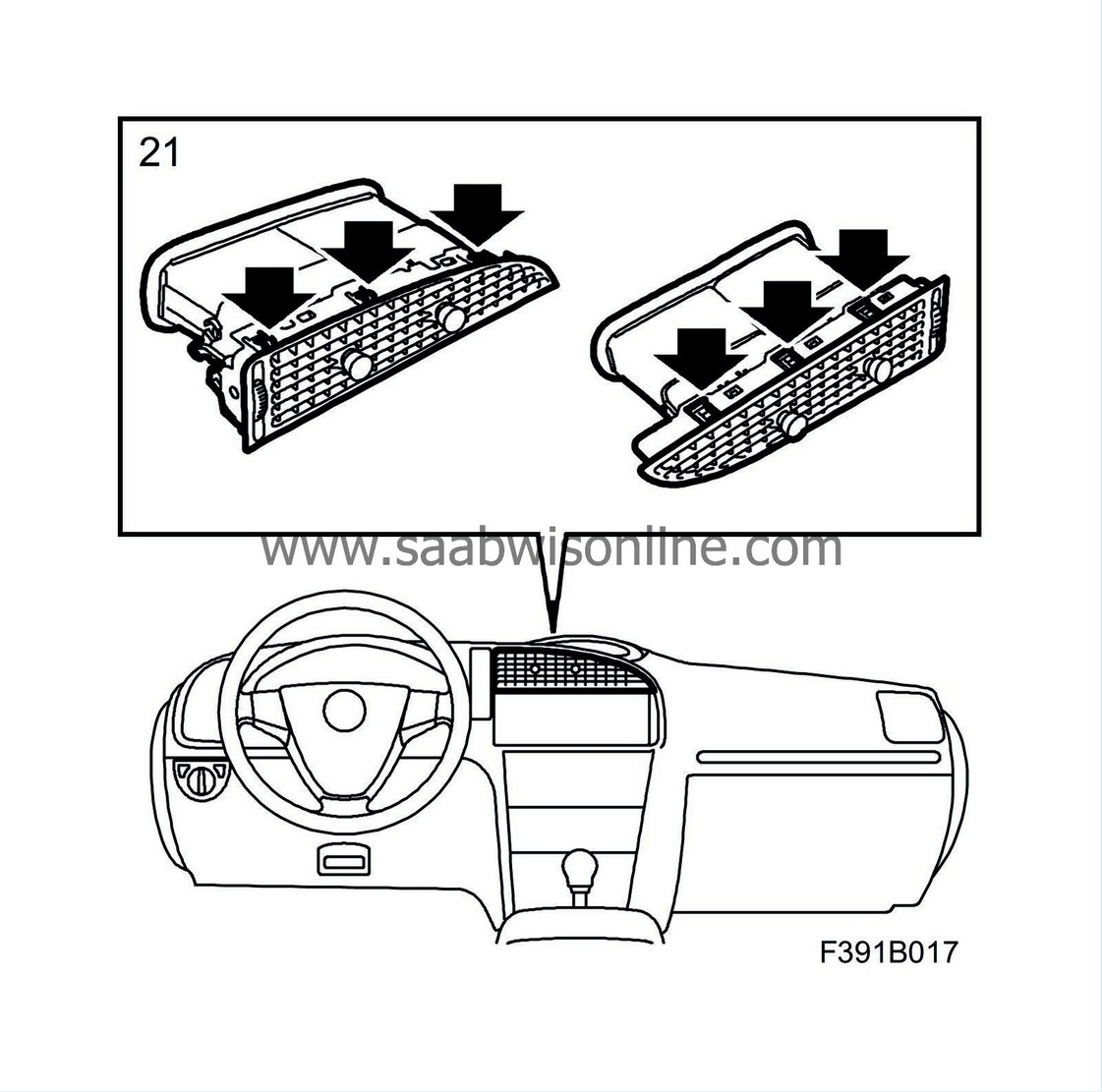
|
|
22.
|
Check the fit, play and functionality of the cupholder.
|
Initial procedure
|
1.
|
Remove fuse 23 (40A maxi fuse) from the dashboard fuse
box.
|
Important
|
|
The battery must be charged before SPS programming. The battery charger
must be able to provide 20 A.
|
|
The charging voltage for the battery charger may not exceed 16 V as
the electronics in the car may be damaged.
|
|
|
|
|
2.
|
Connect the battery charger to the car battery.
|
|
3.
|
Connect Tech2 to the car's data link connector and to
a PC with TIS 2000.
|
|
4.
|
Get Security Access to Tech2
from the car.
|
SPS programming of ICM
|
1.
|
Request data from ICM using Tech2.
|
|
2.
|
Download the SPS program from TIS 2000 to Tech2.
|
|
3.
|
Download security access from TIS 2000 to Tech2.
|
No special procedures are required during the programming phase. Follow
the instructions in TIS 2000 and Tech2 for SPS. Programming will stop for
a few seconds at 0.9%; this is normal.
|
Important
|
|
If programming fails and the control module is in "boot mode", follow
these instructions:
|
|
1.
|
Turn the ignition key to the "START" position.
|
|
2.
|
Remove fuse F2 from the dashboard fuse box.
|
|
3.
|
Program the control module. Ignore the message "switch off/on
ignition" during the programming phase.
|
|
4.
|
Fit fuse F2 after successful programming.
|
|
5.
|
Turn the ignition key to "OFF".
|
|
|
"Add" ICM
For help in selecting the correct option, see the help information in
supplement D2. Several of the car's control modules are married when “Add”
is executed for this control module.
|
Note
|
|
Tech2 can sometimes lose contact with MIU (Main Instrument Unit). If
this is the case, press "Exit" twice and restart "Add".
|
If Tech2 receives a “negative response” from AMP1, do as
follows:
|
1.
|
Turn the ignition key to the "LOCK" position.
|
|
2.
|
Remove fuse F14 from the dashboard fuse box.
|
"Add" ACC
For help in selecting the correct option, see the help information in
supplement D2. Several of the car's control modules are married when “Add”
is executed for this control module.
SPS programming of EHU (only cars up to VIN 31019810)
|
1.
|
Request data using Tech2.
|
|
2.
|
Download the SPS file from TIS 2000 to Tech2.
|
No special procedures are required during the programming phase. Follow
the instructions in TIS 2000 and Tech2 for SPS.
Spontaneous interruption during SPS programming of the EHU sometimes
occurs. Attempt programming restart a few times. If this is not successful,
do as follows:
|
1.
|
Turn the ignition key to the "LOCK" position.
|
|
2.
|
Remove fuse F14 from the dashboard fuse box.
|
"Add" EHU (only cars up to VIN 31019810)
For help in selecting the correct option, see the help information in
supplement D2. Several of the car's control modules are married when “Add”
is executed for this control module.
|
Note
|
|
Tech2 can sometimes lose contact with MIU (Main Instrument Unit). If
this is the case, press "Exit" twice and restart "Add".
|
Replacing the Communication Unit (CU)
Replace the Communication Unit (CU). See Supplement D3 “Replacing
the Communication Unit (CU)”.
"Add" CU
For help in selecting the correct option when "adding" the unit, see
the help information in supplement D2. Several of the car's control modules
are married when “Add” is executed for this control module.
"Add" ICM
“Add” ICM is repeated so that control module configuration
with the correct telephone parameters occurs. For help in selecting the correct
option, see the help information in supplement D2. Several of the car's control
modules are married when “Add” is executed for this control module.
|
Note
|
|
Tech2 can sometimes lose contact with MIU (Main Instrument Unit). If
this is the case, press "Exit" twice and restart "Add".
|
If Tech2 receives a “negative response” from AMP1, do as
follows:
|
1.
|
Turn the ignition key to the "LOCK" position.
|
|
2.
|
Remove fuse F14 from the dashboard fuse box.
|
|
E. Final procedure and functionality check
|
|
1.
|
Disconnect the battery charger from the car.
|
|
2.
|
Fit fuse 23 into the dashboard fuse box.
|
|
3.
|
Check the time and date in SID; adjust as necessary.
|
|
4.
|
Cars with pinch protection:
Set pinch
protection for the window lifts.
|
|
5.
|
Read diagnostic trouble codes to ensure that no faults remain.
|
|
6.
|
Disconnect Tech2 from the car's data link connector.
|
|
7.
|
Check the functionality of the OnStar system.
|
|
|
7.a.
|
Press the "OnStar Services Button" once. An audio message is then
played from the speakers.
|
|
|
7.b.
|
End by pressing the "White dot button".
|
|
Time/Warranty information
|
See separate information.
|
|
|
|
|
|
|
|
|
|
|
VIN
|
|
|
|
|
|
|
|
|
|
|
|
|
|
|
Parking Assistance
|
|
|
Parking Heater
|
|
|
|
|
Rear CD-Changer
|
|
|
Block heater, Time Relay
|
|
|
|
|
|
|
|
|
|
|
|
|
Unit
|
Procedure
|
Info
|
Notes
|
OK/ Not OK
|
|
1
|
|
Fill in the checklist header
|
|
|
|
|
2
|
Cupholder/OnStar keypad
|
Replacing the cupholder
|
|
|
|
|
3
|
Dashboard fuse box
|
Remove fuse 23 (ventilation fan)
|
|
|
|
|
4
|
Battery
|
Connect battery charger
|
|
|
|
|
5
|
Tech2
|
Connect Tech2.
|
|
|
|
|
6
|
Tech2
|
Get Security Access from car
|
|
|
|
|
7
|
ICM
|
Request data
|
|
|
|
|
8
|
TIS 2000
|
Download SPS program from TIS 2000 to Tech2
|
|
|
|
|
9
|
TIS 2000
|
Download security access from TIS 2000 to Tech2
|
|
|
|
|
10
|
ICM
|
SPS programming (approx. 7 min.)
|
|
|
|
|
11
|
ICM
|
Add
|
|
*1, *2
See appendix D2
|
|
|
12
|
ACC
|
Add
|
|
See appendix D2
|
|
|
13
|
EHU
|
Request data
|
Only affects cars up to VIN 31019810
|
*3
|
|
|
14
|
TIS 2000
|
Download SPS program from TIS 2000 to Tech2
|
Only affects cars up to VIN 31019810
|
*3
|
|
|
15
|
EHU
|
SPS programming (approx. 18 min.)
|
Only affects cars up to VIN 31019810
|
*3
|
|
|
16
|
EHU
|
Add
|
Only affects cars up to VIN 31019810
|
See appendix D2
|
|
|
17
|
CU
|
Replacing the Communication Unit (CU)
|
|
|
|
|
18
|
Tech2
|
Get Security Accessfrom car
|
|
|
|
|
19
|
TIS 2000
|
Download security access from TIS 2000 to Tech2
|
|
|
|
|
20
|
CU
|
Add
|
|
See appendix D2
|
|
|
21
|
ICM
|
Add
|
|
*1, *2
See appendix D2
|
|
|
22
|
Battery
|
Disconnect battery charger
|
|
|
|
|
23
|
Dashboard fuse box
|
Fit fuse 23 (ventilation fan)
|
|
|
|
|
24
|
SID
|
Check time and date; adjust as necessary.
|
|
|
|
|
25
|
Door control module
|
Set pinch protection
|
Only affects cars with pinch protection
|
|
|
|
26
|
Tech2
|
Read diagnostic trouble codes
|
|
|
|
|
27
|
Tech2
|
Disconnect Tech2
|
|
|
|
|
28
|
OnStar
|
Check the functionality of the OnStar system
|
|
|
|
|
Notes
|
Description
|
Procedure
|
|
*1
|
Lost communication with MIU.
|
Press "EXIT" twice and restart "Add" program
|
|
*2
|
"Negative Response" from AMP1.
|
Turn off ignition. Remove fuse 14 from the dashboard fuse box, wait
10 seconds and refit the fuse. Press "EXIT" twice and restart "Add" program.
|
|
*3
|
Error during SPS EHU.
|
Turn off ignition. Remove fuse 14 from the dashboard fuse box, wait
10 seconds and refit the fuse. Turn on ignition and press "Retry".
|
ICM
|
Selection
|
Help information
|
|
Steering Wheel Position
|
Select “Left”.
|
|
Engine Fuel Type
|
Select “Petrol”.
|
|
Air Condition Control
|
MCC is manually controlled climate control. The panel has no display.
ACC is automatically controlled climate control. The panel has a display.
|
|
Parking Assistance
|
Four sensors are mounted in rear bumper if equipped with SPA.
|
|
Parking Heater
|
See the comment under “D. Update of car software and hardware
replacement”.
|
|
Rain Sensor
|
Rain sensor is mounted on windscreen at rear-view mirror.
|
|
Theft Alarm
|
All vehicles with theft alarm have a tilt/movement detector mounted
in the overhead console. Detectors are visible through the two grilles in
roof console.
|
|
Trip Computer
|
Check if more than four trip computer functions can be displayed on
SID. If so, the vehicle is equipped with trip computer.
|
|
Seat Heater
|
Check for buttons on climate control panel.
|
|
Seat Ventilation
|
Select "
Without".
|
|
Block heater, Time Relay
|
See the comment under “D. Update of car software and hardware
replacement”.
|
|
Telephone
|
Select "
OnStar/
Telematics
".
|
|
Telephone Type
|
Select "
AMPS".
|
|
Rear CD-Changer
|
Select the correct response. Check in the compartment on the left rear
in the trunk.
|
|
CD player in dash
|
CDF (CD Front) is a panel-mounted CD Player for one disc. The player
has an Eject button only on the panel.
CDCF (CD Changer Front) is a panel-mounted CD changer for six discs.
The changer has one button for each disc on the panel.
|
|
Navigation System
|
Select "
Without".
|
|
Radio Type
|
Select the correct response.
|
|
Country setting
|
Select the correct response.
|
|
Market
|
Select the correct response.
|
|
Language Selection
|
These languages are supported by control module software. Select language
to be displayed on SID (and ICM if equipped with display).
|
|
Tech2 suggests values for next scheduled service.
|
Check that the next scheduled service value is correct, change if necessary
(see table below).
Enter the number of
Days Since
Intermed. Service
. Count the number of days since the intermediate
service, see “Warranty and Service Record booklet”. If the car
has not yet been serviced, count the number of days since the Delivery Service.
Note that the value is set to 999 when the ICM is SPS programmed.
|
Example of Service Screen
|
Next Main service
|
048 000 km
|
|
Next Intermediate Service
|
023 136 km
|
|
Days
SINCE
Int. Service
|
006 days
|
|
Next Main Service Occasion
|
1
|
Service interval (ICM)
|
|
Warranty and Service Record booklet
|
Tech2 Screen
|
|
1st Main service (km)
|
48 000
|
48 000
|
|
2nd Main service (km)
|
96 000
|
96 000
|
|
Intermediate Service (km)
|
24 000
|
23 136
|
ACC
|
Selection
|
Help information
|
|
Steering Wheel Position
|
Select “Left”.
|
|
Engine Fuel Type
|
Select “Petrol”.
|
|
Parking Heater
|
See the comment under “D. Update of car software and hardware
replacement”.
|
|
Market
|
Select the correct response.
|
CU
|
Selection
|
Help information
|
|
Telephone
|
Select "
OnStar/
Telematics
".
|
EHU
|
Selection
|
Help information
|
|
Control Panel
|
Unit
without display is ICM1
Unit with display is ICM2
|
Replacing the Communication Unit (CU)
|
Important
|
|
Handle the fibre optic cables with care or the signal may be distorted.
|
|
•
|
It is very important that the two leads in the connector are not
confused with one another.
|
|
•
|
Do not splice the cables.
|
|
•
|
Do not bend the cable in a radius smaller than 25 mm.
|
|
•
|
Do not expose the cable to temperatures exceeding 85
°
C.
|
|
•
|
Keep the cable ends free from dirt and grime.
|
|
•
|
Do not expose the cable to impact as this may cause the transparent
plastic to whiten, thereby reducing the intensity of the light and causing
possible communication interruptions.
|
|
•
|
The cable should not lie against any sharp edges as this may cause
increased signal reduction.
|
|
|
 Warning
Warning
|
|
The visible red light is laser class 1. Do not look directly into the
optical fibre or the control module connector at a close distance. Distances
of less than 20 m between eye and light source can result in damage to the
eye.
|
|
|
|
|
|
|
1.
|
Fold down the back rest in the rear seat.
|
|
2.
|
Remove the clips holding the parcel shelf trim.
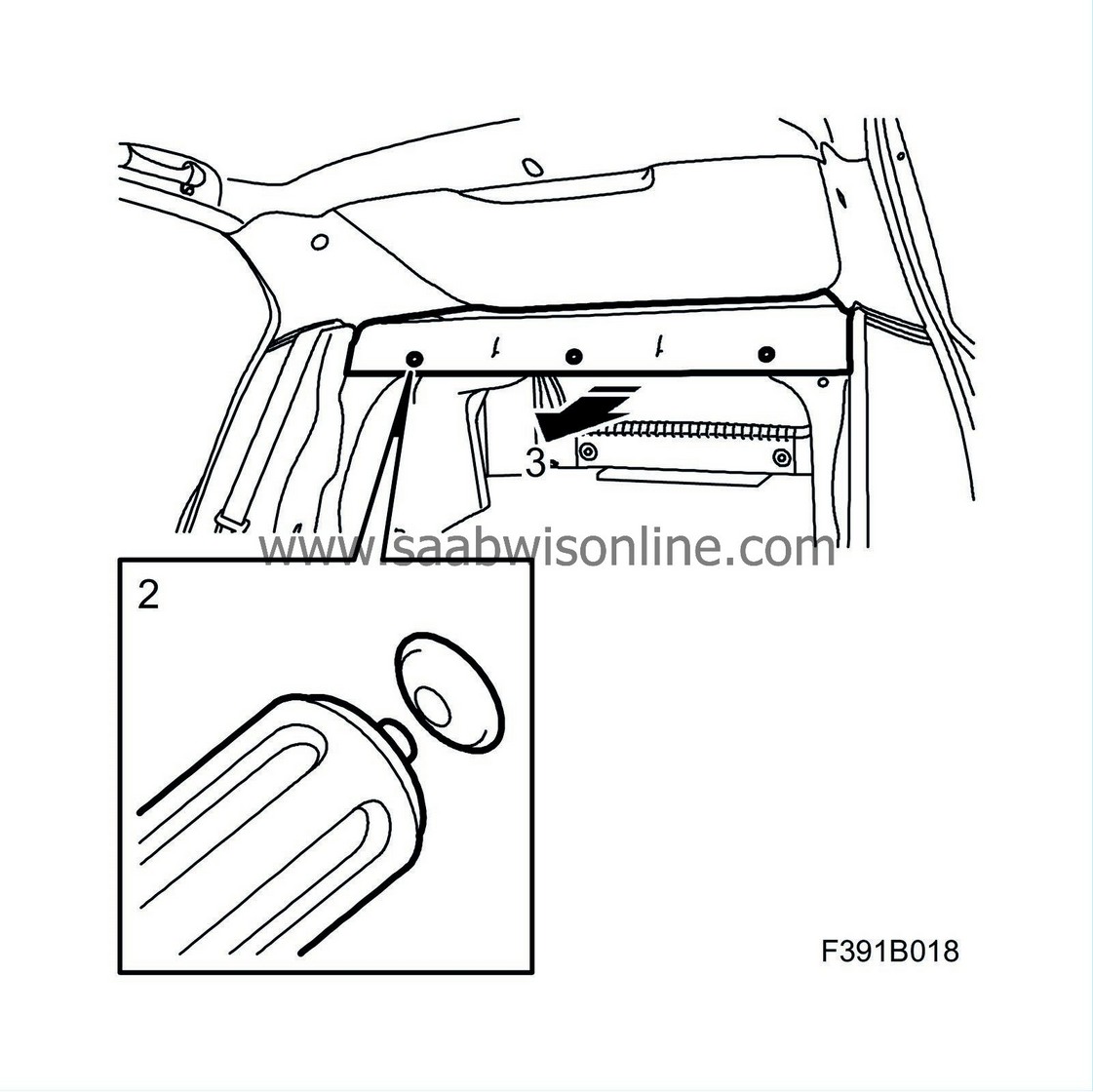
|
|
3.
|
Draw the parcel shelf trim straight out forwards.
|
|
4.
|
Remove the screws.
|
Important
|
|
ESD-SENSITIVE COMPONENT
|
|
Ground yourself by touching the car body before removing/connecting
the component's contact.
Do not touch the component's pins
.
|
|
When the control module is replaced
|
|
• Keep the new control module in its packaging as long as possible.
|
|
• Deposit the replaced control module in the returns packaging
without touching its pins.
|
|
|
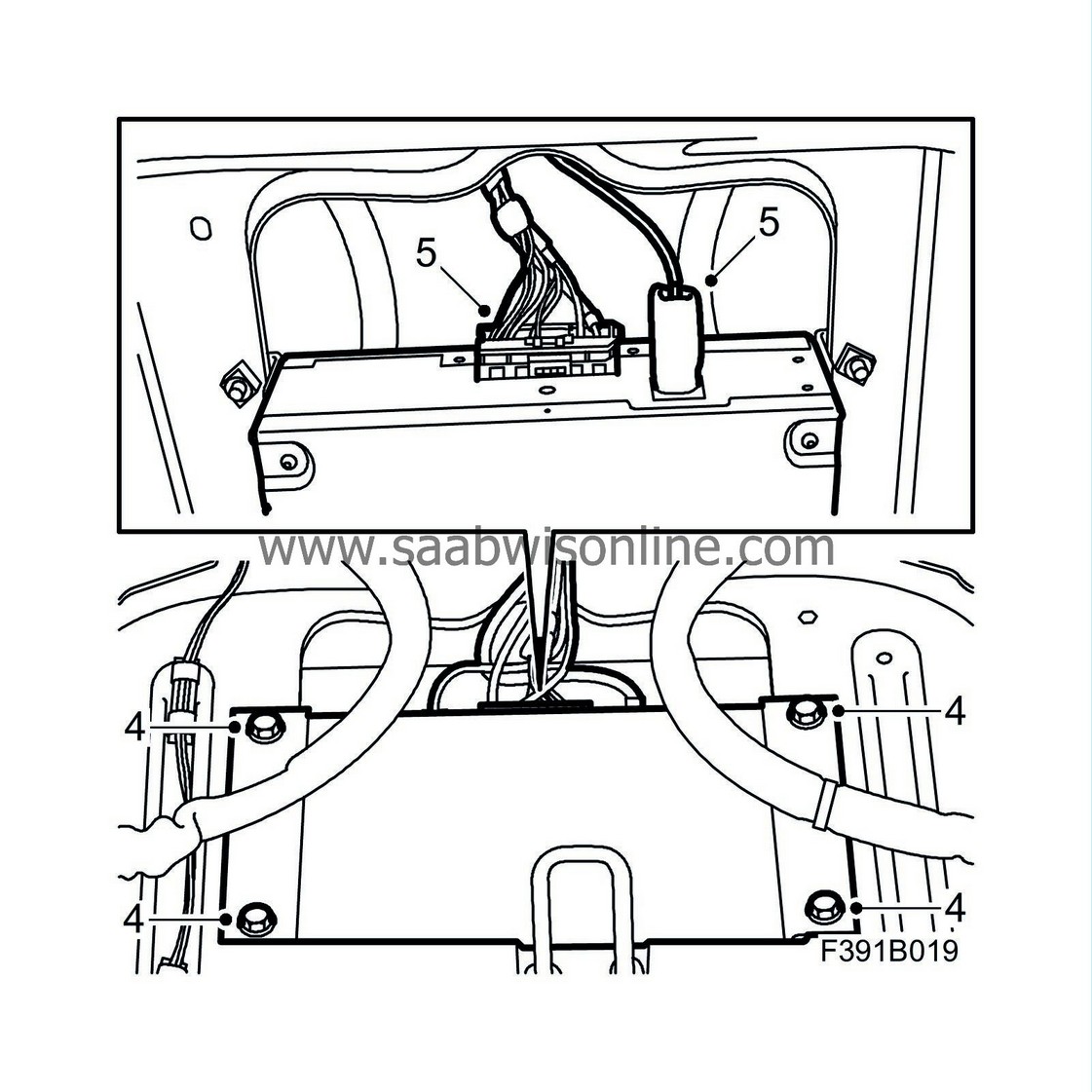
|
|
6.
|
Lift out the communication unit.
|
|
7.
|
Set the new communication unit in the correct position.
|
|
8.
|
Connect the connector.
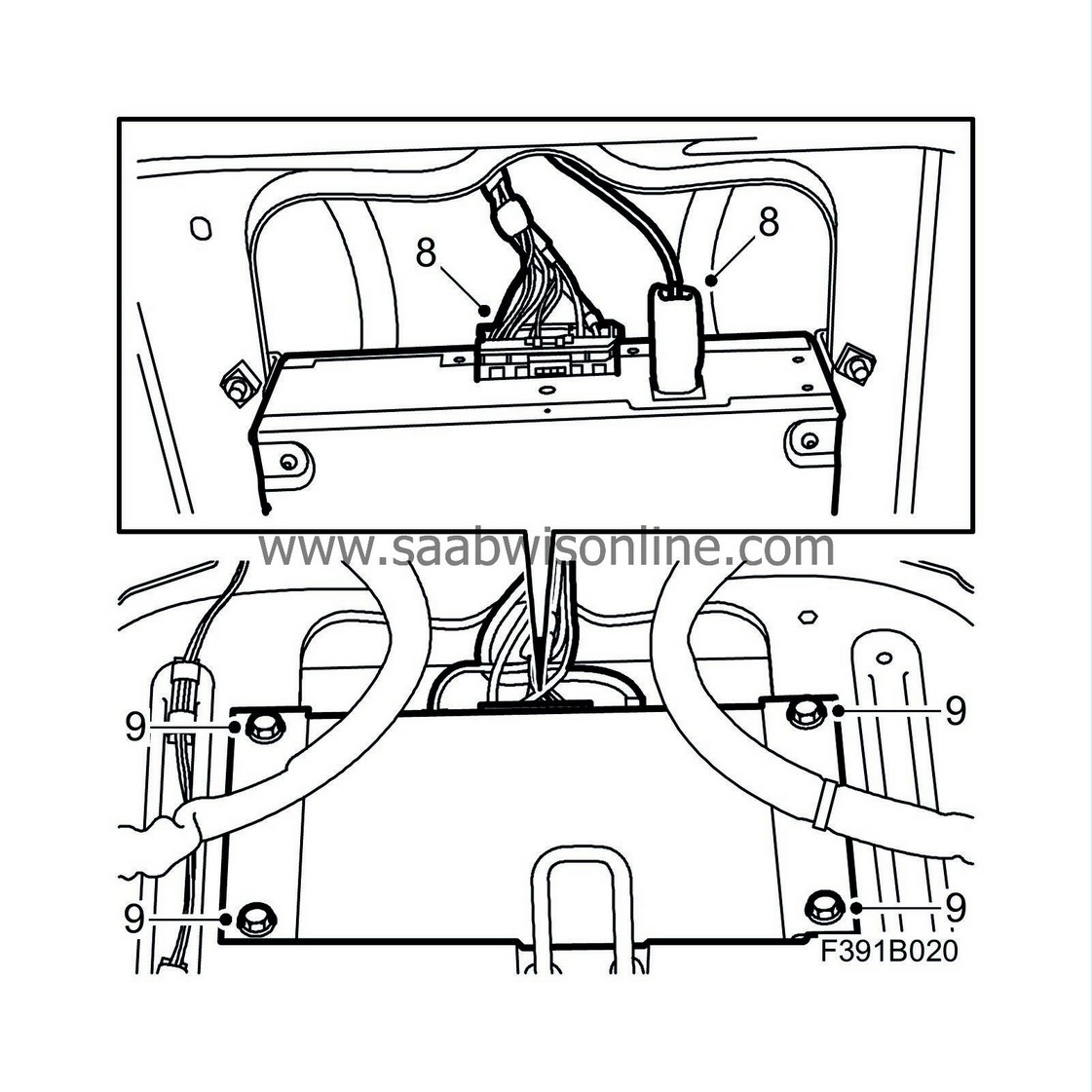
|
|
10.
|
Slide in the parcel shelf trim. Make sure the lugs fully engage
the mountings in the parcel shelf plate.
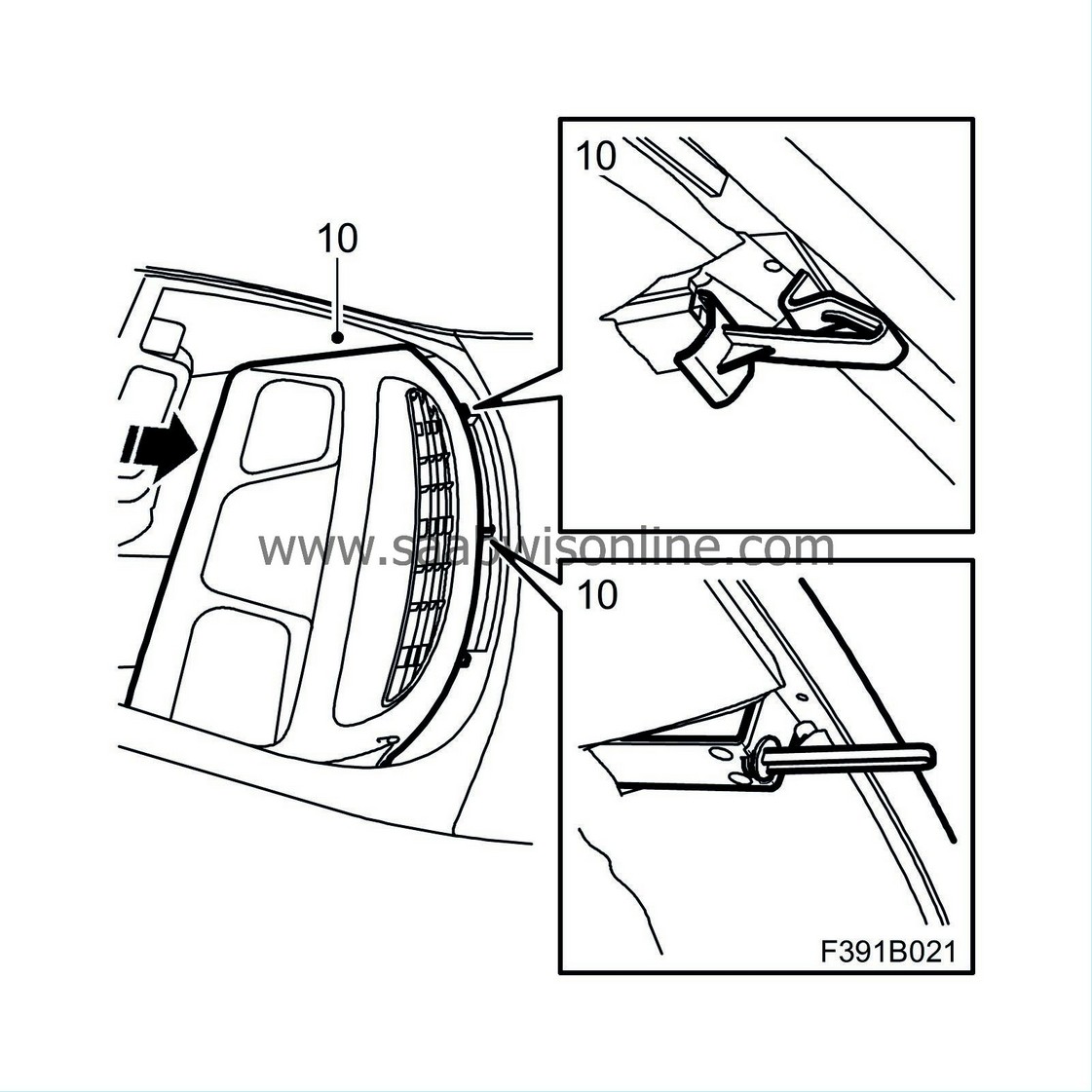
|
|
11.
|
Fit the clips to the parcel shelf trim.
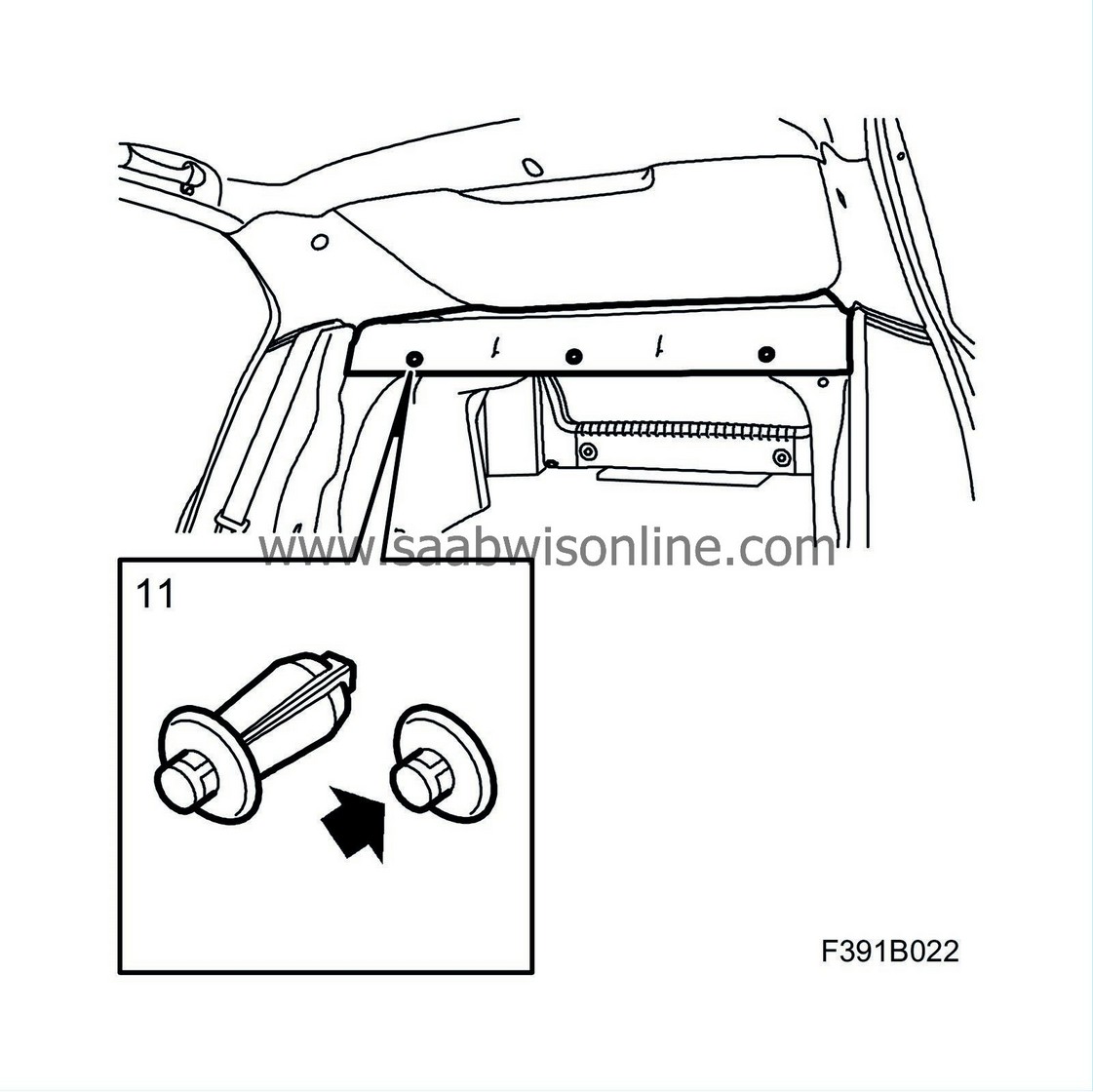
|
|
12.
|
Fold up the back rest. Check that the back rest is locked.
|























 Warning
Warning

